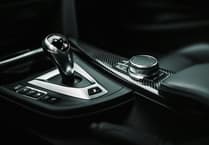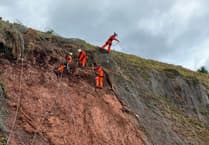SOME words in defence of the Forest's beleaguered wild boar population, because they seem to be the target of a concerted barrage of flak these days. Not all of it entirely politically unmotivated, I feel.
"Nasty", "destructive", "could cause an accident", "a massive problem", "out of control". All epithets recently bandied about in these columns by various correspondents, some with the courage of their convictions to sign their names, others as usual hiding behind the "Name and address supplied" cop-out. Let's have a look at this and see if these are fair comments, or whether such barbs could just as accurately be aimed at us humans.
Yes, the boar do make a mess. So do the forestry's private-hire cutting crews, offroad mountain bikers and illegal woodland motorcyclists and quad-bike riders, flytippers and litterbugs, people who fly-park heavy vehicles on grassy banks and ruck up the turf, and some of the tourists and quite a few of the locals.
As it happens, for nearly six years now I've been forced to clean up the litter and junk deposited weekly in the woods around Cinderford, since otherwise I would be walking through a tip, and I am disgusted by the way some people round here behave, young and old, rich or poor, traditional "Foresters" or newly arrived incomers.
Woodland glades left knee-deep in lager cans, broken glass and drug paraphernalia; trees and young saplings wrenched down to provide fuel for bonfires or simply for warped "fun"; burnt-out cars and motorcycles ditched on the Dean's grassy tracks. Forgive me, but it wasn't the boar who recently started a spate of flytipping all down the edge of the Edgehills Plantation north of Collafield, in which TV sets, armchairs and worn tyres were deposited at 50-yard intervals along one of the more scenic tracks in that region, all tossed into the roadside undergrowth to cause maximum destruction to the natural scene, and all of it the frequently-recurring handiwork of two-legged scum who have no right to live round here and should be tarred-and-feathered and run out of the Forest on rails.
It's not the boar who for years now have been deliberately covering the ground in clearing after clearing around the rear of Heywood School with smashed bottles and beer glasses, in order that your pets or children can cut themselves on it. Sorry, but the boar don't discard used needles in wooded lay-bys – sometimes carefully balancing them point outwards deep inside bramble thickets so that anyone reaching in for blackberries gets injected with whatever these vermin have left on it. All the handiwork of Homo sapiens ("Wise man"?!).
At least when the boar grub up the ground it's to feed themselves and their young, and there are some scientists who believe such natural rotovating actually benefits the woodland ecology. Not something these thugs and yobbos are ever likely to do.
I have to take exception with some of the remarks made by one of our anonymous correspondents regarding boar numbers and their right to be in Britain in the first place (NAAS, "The boar problem", Review w/e September28). This writer's assumption of 150 breeding females producing "1,500" new wild boar a year would surely have come true already by now, wouldn't it, given the forestry estimate that number or more of sows, and they've been here long enough now for this birth explosion to have come about?
As it is, many observers are postulating a much lower overall population level. And no, it's not true that "European boar were never indigenous to this forest". Wild boar have probably been living in this country since the end of the last ice age, some 13,000 years ago, since the latter period saw the land bridge that joined the southeast corner of the UK to the continent disappear beneath the rising seas to be replaced by the English Channel, and it's unlikely they could have got here in any appreciable numbers after that upheaval since we had by then become an island for the first time.
Certainly, when our Iron Age ancestors tried in vain to repel the invading Roman legions, they matched their opponents' choice of the eagle as their legionary standard by adopting their own battle emblem: a bronze image of a defiant wild boar atop a long wooden staff.
They seem to have admired and respected the animal's dogged bravery in defending its young when under prolonged attack, and felt some fellow-feeling with it, given their own plight. Our Norman and medieval forebears followed suit, using the boar as a heraldic symbol on their shields and coats-of-arms. And when Shakespeare's Sir John Falstaff held court in his favourite Cheapside tavern, guzzling his beloved sack and roguishly trying to entice the young Prince Hal away from the fast-approaching rigours and duties of kingship and glory as Henry V on the mud-sodden field of Agincourt, where else did this take place but in the Boar's Head Tavern? So the wild boar – our wild boar – have a noble and longstanding place in our national history.
These are pigs with pedigree; hogs with heritage. They may well have more right to stand as the iconic emblem of Britishness/Englishness than the lion, which hasn't been seen here since the Stone Age, as witnessed by the remains in King Arthur's Cave at Symonds Yat. We've always identified the latter animal as our national symbol ("the British lion", "Richard the Lionheart," "three lions on the shirt", etc.), but for my money I'd back Caractacus or Boudicca and pick the boar any day.
Slow to anger, phlegmatic, but robust and doughty when protecting itself and its family from unwarranted attack. The British psyche, surely? The embodiment of our race down the ages.
For some months now I've been privileged to watch a small pack of these animals on a regular basis – I won't say where, for obvious reasons – and have found them benign, non-threatening and wholly admirable creatures.
The herd comprises two youngish females and half-a-dozen half-grown youngsters, probably the offspring of the larger of the two sows, who is also the pack leader. l have never failed to be moved by the behaviour of these beasts. The mother's care and concern for her young, aided by the smaller adult female, is touching to watch.
Forever guiding them towards better food sources, or ushering them quickly away from possible danger, she is a credit to her maternal role. I've seen male boars in other herds behave just as devotedly. Were these human parents we are discussing, we would hold them as wholly praiseworthy. As it is, they stand as a mute rebuke to some human parents, who often have no idea – and even less care – where their offspring are or what they are getting up to, and whose neglect of their parental responsibilities is usually the driving factor behind the rise of the feral kids that blight many neighbourhoods these days.
As far as I can ascertain, this pack of boar roam across an area of woods of about four square miles, and there seem to be no other boar herds near to them. Which makes me wonder where the suspiciously high estimates of total boar numbers come from, although given the similarly high estimates of our fallow deer population over the last couple of decades, perhaps I shouldn't be surprised.
Yes, the boars' high birth rate could be a problem, but apparently the forestry say an oral contraceptive will be ready by 2016, which isn't too far off in the future. They're our boar now, it's not their fault they were dumped here by irresponsible owners once the bottom fell out of the boar-meat market. Human greed is the reason they're here – the shallow greed of flibberty-gibbet consumers who rushed to embrace an exciting new dish the moment it became fashionable and who just as quickly deserted it the moment it became "so last year, dahling"; and the greed for profits of those who supplied the demand and then callously abandoned the living meat-providers when they were no longer a moneyspinner.
One way of keeping the boar away from sensitive sites and human habitation might be to use commercially available livestock feed pellets to lure them off into the deeper woods. We are in any case going to have to face the fact that we may need to feed them these anyway in the colder months, to prevent them from approaching the settlements and making a nuisance of themselves. Ominously, the acorn and beech-mast crops don't look particularly plentiful this year. Perhaps there could be a communal kitty set up for people who care about the boar and don't want to see them suffer to contribute to, with sacks of animal feed bought from it when required. I'd be prepared to contribute to this, and I'd hope others would too.
It's a shame there are some who would stigmatise and demonise what is actually a fascinating member of the woodland ecosystem. But, as we've seen with the badger, politics often has a hand in this.
– Andrew Stephens, Prospect Road, Cinderford.




Comments
This article has no comments yet. Be the first to leave a comment.